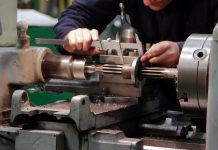 “Made in China” could have high potential. Michele Costabile, director of the master of science in marketing at the Rome-based LUISS University, said China can rely on technological innovation to improve the quality of its products and to move upward in the industrial value chain. The enhancement of “made in China” perception, he suggested, can be designed as a “repositioning strategy” especially focused on markets where the Asian country already has a consolidated strong relationship or where the “made in” competition is weaker.
“Made in China” could have high potential. Michele Costabile, director of the master of science in marketing at the Rome-based LUISS University, said China can rely on technological innovation to improve the quality of its products and to move upward in the industrial value chain. The enhancement of “made in China” perception, he suggested, can be designed as a “repositioning strategy” especially focused on markets where the Asian country already has a consolidated strong relationship or where the “made in” competition is weaker.
“The right solution could be to invest on relatively new products compared to those historically connected with other countries, hopefully tech-intensive, which can spread a positive perception on all the made-in-China products,” Costabile said. In his view, new brands could be launched in order to accomplish the goal of a “2.0 manufacturing nation,” or a sort of “Chinese second wave” qualified by technologies and innovation. Regarding those product categories that are difficult to place on the very high end of the world market, they could be upgraded from “low cost” to “smart value,” meaning goods with very low prices but much higher quality and technologies, the professor said. Such products can be very successful both in emerging and consolidated markets, especially in times of economic crisis. Last but not least, Costabile added, China should try to develop “love brands,” or brands full of symbolism and emotions that customers pay for.
How to reach such ambitious goals? A crucial point is the cross-generational corporate governance changes met by the Chinese family businesses after 30 years of fast economic growth in their country, Costabile noted. In fact, China’s family businesses can benefit from the experiences of companies which have the same problems in other countries to outline the “recipe” to address these changes that is quite easy though very difficult to apply, he highlighted. Three are the core ingredients, according to Costabile. The youngest family members should receive top high levels of education, in part abroad, and possibly have a work experience in other companies to enlarge their skills and professional abilities.
“Finally, the complex and risky journey of the generational change should be always supported by external advisors,” he added. Important steps to support the upgrading of the “made in China” label should be made by government representatives in selecting products, technologies and markets which boast comparative and relative advantages, the professor told Xinhua.
Information, cross-country experiences, agreements on specific issues as well as lobbying initiatives organized by single companies or industrial clusters aimed at deploying new consistent public policies are among the possible actions to promote the revolution of the “made in China” brand, he said. Costabile believes there are “huge opportunities” in the product and market complementarity that ad hoc alliances and co-branding in a global perspective can explore and exploit. For example, many Chinese entrepreneurs are investing in prestigious made-in-Italy brands. The two parts could benefit from trading down their product lines towards a “mass and affordable luxury” market positioning or from trading them up with a “smart value” re-positioning, he said.
Based on new technologies, which enable big manufacturers to adopt practices that once where consistent only with artisans as well as handcrafters to reach global markets with customized products, “the made-in-China Italy manufacturing is not science-fiction scenario,” Costabile stressed. “This is a road to be hit, maybe starting with some product categories that already share a strong and long history, such as the silk, a market that since the Marco Polo era has had some made-in-ChinItaly products performing very well,” he pointed out.



